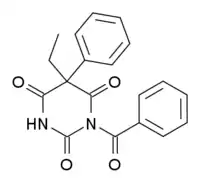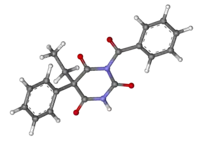Benzobarbital
Benzobarbital (Benzonal) is a barbiturate derivative. It has anticonvulsant effects and has been used for the treatment of epilepsy. [1]
 | |
 | |
| Clinical data | |
|---|---|
| Other names | Benzonal |
| ATC code |
|
| Identifiers | |
IUPAC name
| |
| CAS Number | |
| PubChem CID | |
| ChemSpider | |
| UNII | |
| ChEMBL | |
| CompTox Dashboard (EPA) | |
| Chemical and physical data | |
| Formula | C19H16N2O4 |
| Molar mass | 336.347 g·mol−1 |
| 3D model (JSmol) | |
SMILES
| |
InChI
| |
| | |
It has similar liver enzyme inducing effects to the closely related drug phenobarbital, which may be exploited in some clinical applications. [2] [3]
References
- Okudzhava VM, Chankvetadze BG (1989). "[Pharmacological characteristics of an anti-convulsive drug Benzonal and the evaluation of its therapeutic effectiveness (review of the literature)]". Zhurnal Nevropatologii I Psikhiatrii Imeni S.S. Korsakova (in Russian). 89 (11): 136–45. PMID 2696306.
- Nadzhimutdinov KN, Khakimov ZZ, Kabulov S (1992). "[The advantages of benzonal as an inducer of the liver mono-oxygenase enzyme system compared to phenobarbital]". Eksperimental'naia i Klinicheskaia Farmakologiia (in Russian). 55 (1): 68–71. PMID 1305441.
- Novozheeva TP, Saratikov AS, Grishanova AI, Gutkina NI, Akhmedzhanov RR, Khatsenko OG, Kozlovskaia NE (February 1991). "[Benzonal--a phenobarbital-type of inducer of the mono-oxygenase system]". Biulleten' Eksperimental'noi Biologii I Meditsiny (in Russian). 111 (2): 163–5. OCLC 613807502. PMID 1854958.
This article is issued from Wikipedia. The text is licensed under Creative Commons - Attribution - Sharealike. Additional terms may apply for the media files.